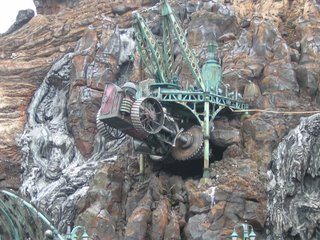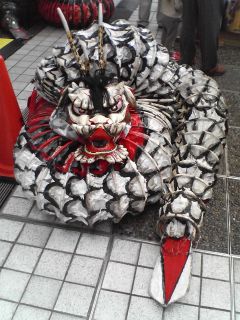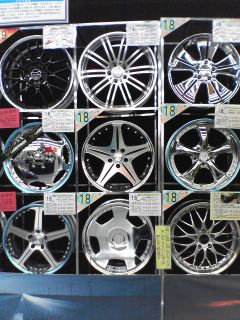
This concludes our broadcast…
While I was away, the bathroom in my Seattle home got a new addition. Staring at this Toto Washlet toilet in my American bathroom, a mirror image of what my rear graced countless times while in Japan, I cannot help but feel that all things come full circle...
A typhoon hit Tokyo during my last week. Tokyo Disney Sea was wet, but when departure day arrived, waves of water rolled down the street near my Asakusa Weekly Mansion and the howling wind was easily audible outside my window. I needed to wire money to my host brother in Kyoto to close out my mobile phone account, so I braved my way through the torrential onslaught, trudging through ankle deep water to a nearby convenience store ATM.
Even with written directions from my host brother on how to transfer money to his account (displayed on my cell phone in Japanese characters), I was still completely baffled by the electronic process and had to enlist the help of the friendly store clerk. He was very patient and I eventually got the money sent after several unsuccessful attempts at punching buttons on the machine myself.
Japanese ATMs also have no deposit or withdrawal limits, so I was able to take all of my summer internship earnings with me in a huge stack of cash – just like an international drug dealer. I left a hundred dollars in the account to keep it open. Now, when I become a super villain, I can rightfully say that I have an “offshore account.”
After the banking was taken care of (and I was thoroughly soaked from the roundtrip), I was ready to check out and head to the airport. Leaving my Asakusa Weekly Mansion was a painless affair. There were no additional charges on my account, so I signed a piece of paper and walked out the door. I can’t say that I was particularly sad to leave my broom closet prison cell.
A special train line runs directly from nearby Ueno to Narita International Airport. The ride was very quick, clocking in at only a little over an hour, but the train cars were absolutely packed with people. I had to stand for ¾ of the ride, smashed in between people and pieces of rolling luggage, as the train sped through the icy rain. Luckily I had shipped my luggage ahead to the airport so I only had to deal with a backpack.
United Airlines only allows two pieces of checked baggage, so I had to pay the equivalent of $170 in yen in order to check my third bag. I was infuriated at the astronomical cost, but there was nothing I could do – the airline had me over a barrel. I spent my time in the airport looking in the shops (they have a whole mall in the airport). There is also an observation field with benches and tables where one can sit and watch the planes take off.
I don’t remember how long the flight back was, but it was certainly shorter than the trip over. I watched several movies and ate the same crummy vegetarian pilaf. Before I knew it, I was staring at a blue customs declaration form on my tray table. I had no idea what to write on the form as I was bringing back suitcases filled with CDs, DVDs, and videogames. Most of my booty was personal gifts or unmarked audio / video product samples from Columbia, so I didn’t know how to accurately estimate their value on the form. I filled in some ballpark prices and took a gamble that the customs agents wouldn’t care.
In customs, one particularly annoying male agent decided to harass any person under the age of 25. He paced around the group and interrogated any college-age kid he could find. Things went well once I told him I was a Stanford student and started gushing about my summer internship at Columbia, after he asked me to describe what I did in Japan. Not knowing anything about Japan, the agent quickly disengaged me. He stared at my blue form with the itemization “CDs / DVDs = $500” and then stared at me. “Five hundred dollars huh? That’s how much it cost? You’re not bringing back like hundreds of CDs are ya?”
I didn’t have the heart to tell him that he was actually correct – Instead, I told him that CDs and DVDs are very expensive in Japan (which isn’t a lie). All things considered, customs was just fine. The only things the authorities seemed concerned with were powdered or liquid curry packets. Since I didn’t have either, I was home free.
…I am now in my senior year at Stanford, and busy myself with advanced coursework in Japanese language and literature, preparing for the Ministry of Education’s national proficiency exam. I am also writing an honors thesis for my major on the subject of the all-female Takarazuka Revue Theatre Company.
I hope that my stories were funny and entertaining when they needed to be, but also educational and inspiring as well. If you enjoyed my adventures and learned something new about Japan, then I did a good job. Japan is truly a country unlike any other in the world and a place that I love dearly. I urge all of you to experience it first hand. What are you waiting for? Make your own adventures!
Finally, I would like to thank all of the friends, family members, and strangers who read, commented on, and enjoyed A White Boy in Japan. Usually blogs like this only benefit school friends and grandparents. I feel privileged to have had people from all over the world reading my musings.
This blog will remain active and open from now on. It is now possible to read my entire adventure from beginning to end! While frequent updates on the site will drop to a minimum, I will post any and all new information regarding my senior thesis, Japan job search, and future Japan trips on this website, so please don’t forget the address!
I will leave you with my favorite Japanese quote, straight from the special edition DVD poster:
「自分が見えない時は、ライオンキングを見ればいい」
“When you forget who you are, watch Disney’s The Lion King.”
Thank you for reading.
Most Sincerely,
Benjamin Evan Whaley
A White Boy in Japan
















































